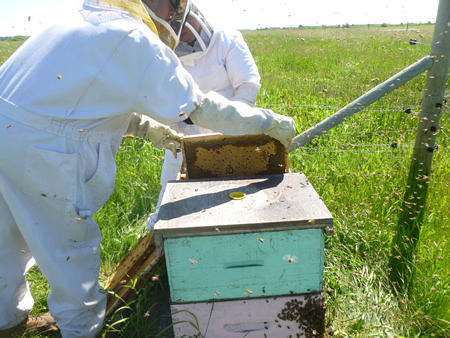Beekeepers keeping healthier hives
 Robert and Margaret Smith checking one of their hives.
Robert and Margaret Smith checking one of their hives.Manitoba's honey bee producers can now better identify diseases in their hives with help from information workshops and biosecurity tools and strategies.
Robert and Margaret Smith, owners of Marg's Honey Inc. in St. Andrews, decided to take part in the initiative and purchase a microscope to make sure they know the level of disease in their hives immediately.
"We want to be able to monitor the diseases on our own," Margaret Smith said. "Having the tools lets us know when to treat the bees and what kind of treatment we should use, instead of just guessing."
More experience gives wider options
Robert and Margaret began beekeeping in 1977 with just four hives. They now manage more than 500 hives and produce close to 70,000 pounds of honey in a season. Although they did take a Bee Masters course at Simon Fraser University, the Smiths said it's important to have a refresher on identifying diseases. Under the Growing Forward 2 - Growing Assurance program, the Smiths were able to purchase a microscope to monitor diseases at their hive.
"We can do this ourselves now, instead of having to wait for the results from the lab. It takes a while for the lab to process and by then it might be too late for treatment. Under the microscope we can dissect a number of bees and determine the infection level by how many spores we see. From there, we decide if they need a short term powder treatment they can just lick off each other, or if they need a more long-term treatment," said Robert Smith.
In Manitoba, Nosema is an important bee disease which is caused by a fungus that affects the gut of a bee, reducing its ability to absorb nutrients and therefore significantly shortening its life. It is spread to other bees through contaminated feces, most often during the winter months when they cannot take cleansing flights. An easy indicator of Nosema apis infection is feces on the front of a hive, however this is not a symptom of the newer species, Nosema ceranae, making it harder to detect.
"We want to have healthy bees, so they can produce lots of honey," Margaret Smith said.
New comb to improve bee health
Another measure the Smiths have taken to keep their hives healthy is joining the brood comb exchange program. Originally, they took part in the program through Growing Forward and have continued with Growing Forward 2.
"It's important for producers to change their comb for the health of the bees in their hive," says David Ostermann, pollination apiarist at Manitoba Agriculture, Food and Rural Development. "It's a soft material. You get spores from diseases on the comb and the spores can re-infect other bees. The older the comb, the more likely it is to have disease."
Beekeepers face a number of challenges when it comes to bee biosecurity and health, including diseases, mites, chemical risks and uncertainties and long winters.
The Smiths have been rotating 10 per cent of their comb each year, which averages to two to three frames of comb per hive. Under the brood comb exchange program, beekeepers can take their comb to MacGregor Wax Works, where the old comb will be melted down and used for other products.
The microscope, workshops and comb exchange are all cost-shared programs under Growing Forward 2's - Growing Assurance program. Manitoba's beekeepers are encouraged to apply for this funding to better monitor and maintain the health of their bees. These tools help to prevent the growth of infection that can slow a business and instead help to move the business forward.



